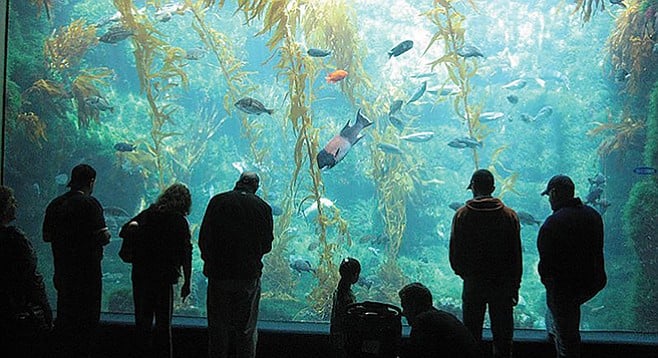 Facebook
Facebook
 X
X
 Instagram
Instagram
 TikTok
TikTok
 Youtube
Youtube

With a growth rate equal to bamboo at up to two feet per day, kelp forests along California’s coast have been harvested since World War I. The first large industrial uses of kelp were for potash to make gunpowder and fertilizer for farming. Kelp was harvested then by wrapping the lower stalk with cable, a process that usually ripped the plant up from its root, or “holdfast,” attached to rock between 20 and 80 feet deep.
Kelp’s value in food, pharmaceutical, and industrial applications has led to the collection of 120,000 metric tons a year by ships fitted with kelp-cutting machinery. It keeps ice cream smooth, prevents ink from sinking through paper, suspends the spices in salad dressing, and helps a coat of paint lie down so you can’t see the brush strokes when dry.
After nearly 1500 kelp operations shut down after the end of the First World War in 1918, the business in San Diego didn’t revive until Kelp Co began in National City in 1929. Pulling kelp by the roots was strenuous labor; San Diego State football players in the 1930s were hired to get the kelp.
In the 1950s, the Scripps Institute of Oceanography in La Jolla began studying the effect of the harvesting industry on fish and other animals depending on the kelp canopy. Despite modern techniques of sustainable harvesting, local harvesting companies have left for areas like Scotland.
Scripps is offering Kelp Kornucopia from 11 a.m.–3 p.m. on Saturday, November 21, where visitors can interview Scripps coastal researchers, watch an interactive kelp tank dive show, and get hands slimy with real kelp. The program is included with aquarium admission.


With a growth rate equal to bamboo at up to two feet per day, kelp forests along California’s coast have been harvested since World War I. The first large industrial uses of kelp were for potash to make gunpowder and fertilizer for farming. Kelp was harvested then by wrapping the lower stalk with cable, a process that usually ripped the plant up from its root, or “holdfast,” attached to rock between 20 and 80 feet deep.
Kelp’s value in food, pharmaceutical, and industrial applications has led to the collection of 120,000 metric tons a year by ships fitted with kelp-cutting machinery. It keeps ice cream smooth, prevents ink from sinking through paper, suspends the spices in salad dressing, and helps a coat of paint lie down so you can’t see the brush strokes when dry.
After nearly 1500 kelp operations shut down after the end of the First World War in 1918, the business in San Diego didn’t revive until Kelp Co began in National City in 1929. Pulling kelp by the roots was strenuous labor; San Diego State football players in the 1930s were hired to get the kelp.
In the 1950s, the Scripps Institute of Oceanography in La Jolla began studying the effect of the harvesting industry on fish and other animals depending on the kelp canopy. Despite modern techniques of sustainable harvesting, local harvesting companies have left for areas like Scotland.
Scripps is offering Kelp Kornucopia from 11 a.m.–3 p.m. on Saturday, November 21, where visitors can interview Scripps coastal researchers, watch an interactive kelp tank dive show, and get hands slimy with real kelp. The program is included with aquarium admission.
Comments